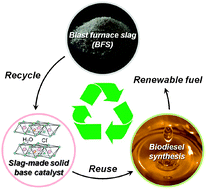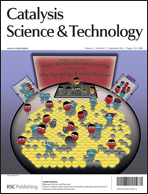Blast furnace slag (BFS), a high volume byproduct resulting from iron-making processes, was used as a low-cost and abundant precursor for preparing a hydrocalumite, and the thus prepared slag-made hydrocalumite and its derivatives were applied for transesterifications of esters including triglycerides. In the transesterification of n-ethyl butyrate, calcined samples provided higher catalytic activities than those of the as-synthesized hydrocalumite due to the interfusion of slag-derived impurity elements, such as Fe and Mn, which act as catalyst promoters. Furthermore, the catalyst calcined at 800 °C in air worked as an efficient catalyst for the transesterification of soybean oil with methanol, affording up to 97% yield of fatty acid methyl esters (FAME) after 6 h under relatively moderate reaction conditions (i.e., methanol/soybean oil = 12, reaction temperature = 60 °C, use of 1 wt% catalyst), and its catalytic performance was reproduced even after air-exposure for 1 day. It is believed that the slag-made hydrocalumite can replace existing solid base catalysts as a low-cost alternative for biodiesel production and potentially contribute to the sustainable chemical processes in an economical and ecological way.

You have access to this article
 Please wait while we load your content...
Something went wrong. Try again?
Please wait while we load your content...
Something went wrong. Try again?


 Please wait while we load your content...
Please wait while we load your content...